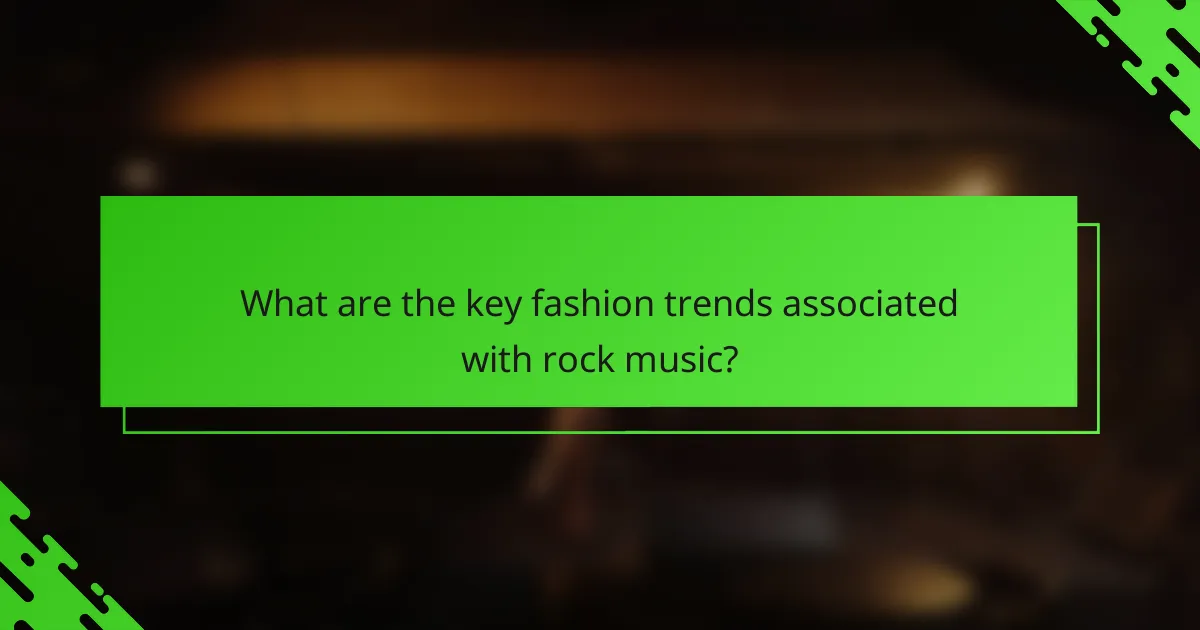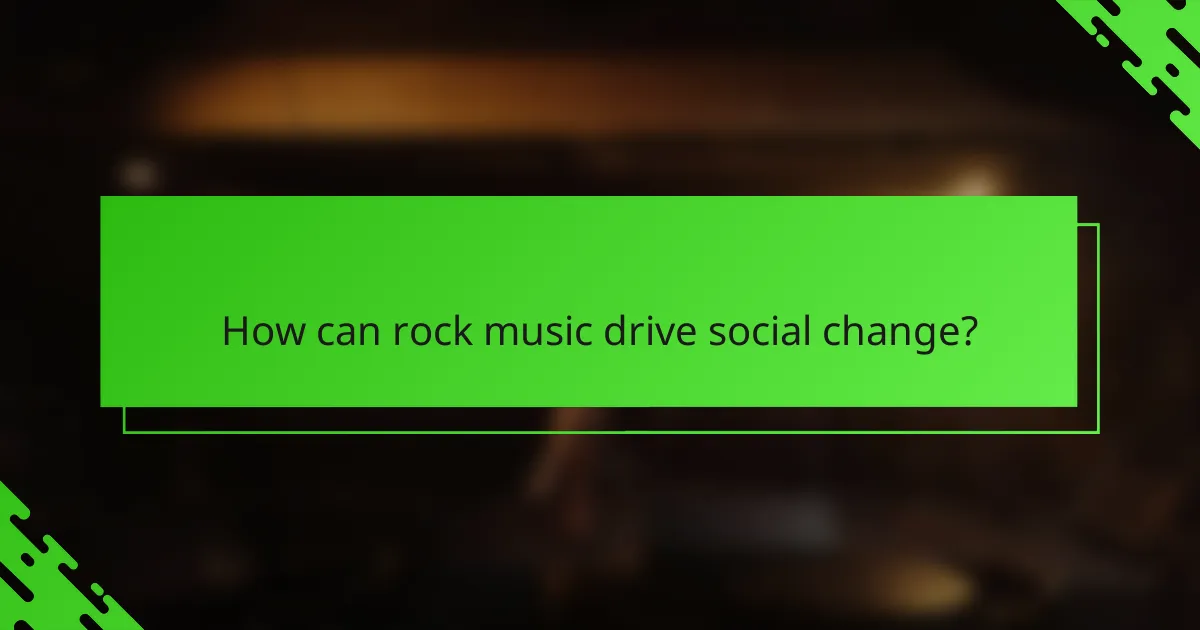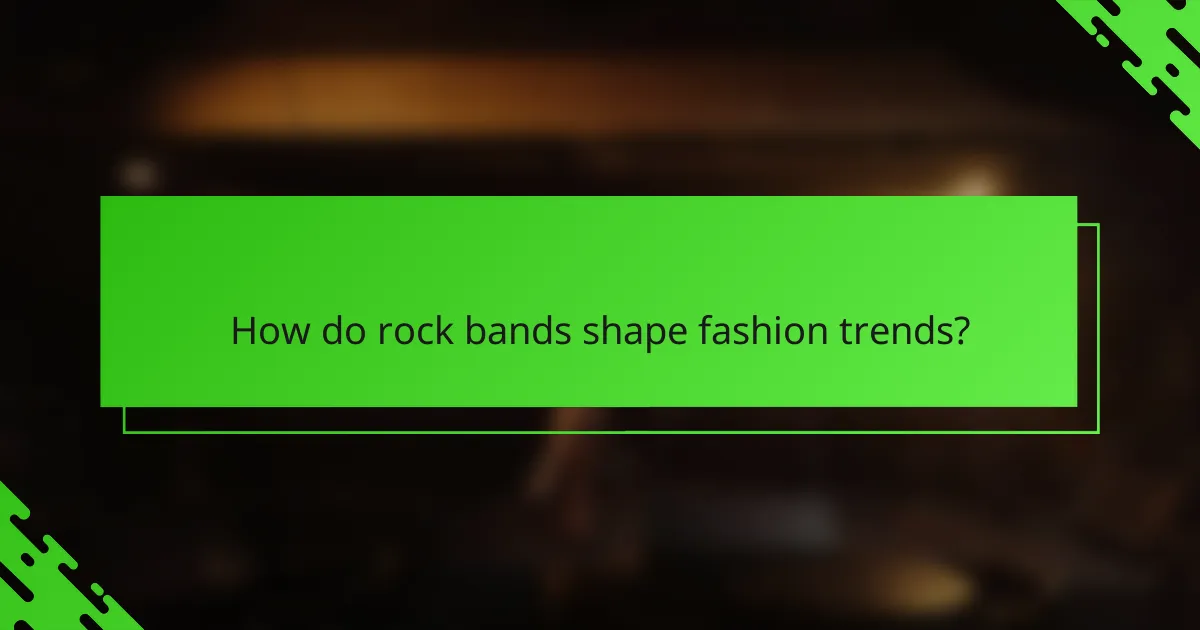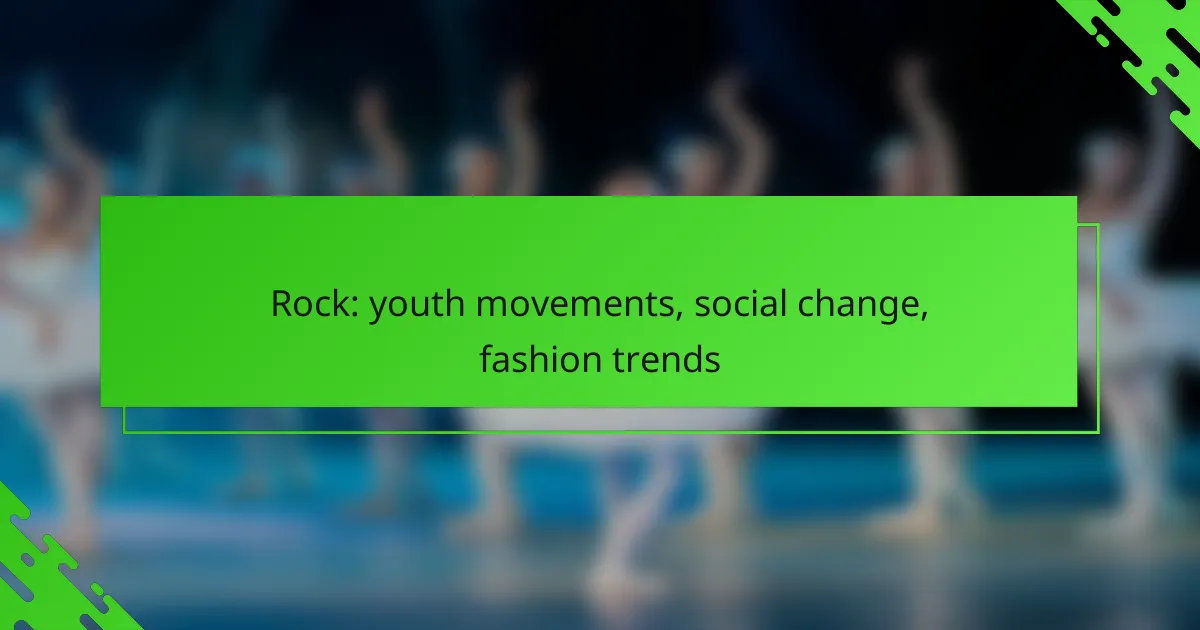Rock music has played a pivotal role in shaping youth movements and driving social change, offering a powerful platform for self-expression and activism. From the counterculture of the 1960s to the punk and grunge eras, it has influenced not only the identity and values of Canadian youth but also the fashion trends that accompany these movements, emphasizing individuality and rebellion. Through its impactful lyrics and performances, rock continues to raise awareness of social issues and inspire collective action for justice and equality.

How has rock music influenced youth movements in Canada?
Rock music has significantly influenced youth movements in Canada by providing a voice for social change and a platform for self-expression. From the counterculture of the 1960s to the punk and grunge movements, rock has shaped the identity and values of Canadian youth across generations.
Counterculture movements in the 1960s
The 1960s saw a surge of counterculture movements in Canada, heavily influenced by rock music. Artists like The Guess Who and Joni Mitchell became symbols of resistance against traditional norms, advocating for peace, love, and social justice.
This era was marked by events such as the Montreal Expo and the rise of anti-war protests, where rock music served as anthems for the youth. Festivals like the Toronto Rock ‘n’ Roll Revival in 1969 highlighted the growing connection between music and social activism.
Impact of punk rock in the 1970s
Punk rock emerged in the 1970s as a raw, energetic response to the mainstream music scene, resonating with disenchanted youth in Canada. Bands like The Diodes and D.O.A. challenged societal norms and encouraged a DIY ethos, empowering young people to express their frustrations through music and fashion.
This movement fostered a sense of community among youth, leading to the establishment of independent music venues and zines. Punk’s influence extended beyond music, inspiring political activism and a rejection of consumerism.
Grunge and the 1990s youth identity
The grunge movement of the 1990s introduced a new wave of youth identity in Canada, characterized by its distinct sound and fashion. Bands like Nirvana and local acts such as The Smugglers resonated with young people grappling with issues of alienation and disillusionment.
Grunge fashion, marked by flannel shirts and combat boots, became a symbol of rebellion against the polished aesthetics of previous decades. This era also saw a rise in discussions around mental health and authenticity, further shaping the youth culture of the time.

What are the key fashion trends associated with rock music?
Key fashion trends associated with rock music include a mix of rebellious styles that often emphasize individuality and self-expression. These trends have evolved over decades, reflecting the cultural shifts and movements within the rock genre.
Leather jackets and denim styles
Leather jackets and denim styles are iconic elements of rock fashion, symbolizing a rebellious spirit. The classic black leather jacket, often adorned with patches or studs, conveys a sense of attitude and defiance.
Denim, particularly distressed jeans and jackets, complements the leather look and is frequently worn by rock musicians and fans alike. This combination creates a rugged aesthetic that remains popular across generations.
Influence of glam rock on fashion
Glam rock introduced a flamboyant style characterized by bold colors, glitter, and extravagant outfits. Artists like David Bowie and T. Rex popularized tight-fitting clothing, platform shoes, and heavy makeup, challenging traditional gender norms in fashion.
This movement encouraged fans to embrace theatricality in their attire, leading to a vibrant subculture that celebrates creativity and self-expression. Glam rock’s influence is still evident in contemporary fashion, particularly in music festivals and alternative scenes.
Streetwear and rock music crossover
The crossover between streetwear and rock music has gained momentum, blending urban styles with rock aesthetics. This trend often features graphic tees, oversized hoodies, and sneakers, appealing to a younger audience seeking comfort without sacrificing style.
Collaborations between rock bands and streetwear brands have further popularized this fusion, making it a staple in modern wardrobes. Fans can express their musical tastes through casual yet trendy outfits that reflect both their love for rock and contemporary fashion trends.

How can rock music drive social change?
Rock music can drive social change by raising awareness of social issues and inspiring collective action. Through its powerful lyrics and passionate performances, rock often serves as a voice for marginalized communities and a catalyst for movements advocating for justice and equality.
Protest songs and activism
Protest songs have long been a staple of rock music, often addressing political and social injustices. Artists like Bob Dylan and Rage Against the Machine have used their music to highlight issues such as civil rights, war, and economic inequality. These songs resonate with listeners, encouraging them to engage in activism and support causes that matter to them.
When creating a protest song, focus on clear messaging and emotional resonance. Aim to connect with listeners through relatable experiences and strong imagery. This can amplify the song’s impact and motivate listeners to take action.
Charity concerts and awareness campaigns
Charity concerts and awareness campaigns leverage the popularity of rock music to support various social causes. Events like Live Aid and the Concert for Bangladesh have raised millions for humanitarian efforts, showcasing how rock musicians can unite fans for a common purpose. These concerts not only generate funds but also educate audiences about pressing issues.
To effectively organize a charity concert, consider collaborating with well-known artists and local organizations. Promote the event through social media and traditional channels to maximize reach. Setting clear goals for fundraising and awareness can help measure the event’s success and impact on the chosen cause.

What are the connections between rock music and youth culture in Canada?
Rock music in Canada has long been intertwined with youth culture, serving as a powerful medium for self-expression and social change. It reflects the values, struggles, and aspirations of young people, influencing their fashion, attitudes, and community engagement.
Local music festivals promoting youth engagement
Local music festivals in Canada play a crucial role in fostering youth engagement through rock music. Events like the Toronto Rock Festival and the Vancouver Folk Music Festival provide platforms for young artists, allowing them to showcase their talents and connect with their peers.
These festivals often feature workshops and discussions that encourage youth participation in the music scene. By promoting inclusivity and diversity, they help cultivate a sense of community among young attendees, inspiring them to express their identities through music and fashion.
Role of social media in rock music culture
Social media has transformed the way rock music influences youth culture in Canada. Platforms like Instagram, TikTok, and YouTube allow young musicians to share their work widely, enabling them to build fan bases without traditional barriers. This democratization of music has led to a resurgence of interest in rock genres among younger audiences.
Additionally, social media serves as a space for discussion and activism, where young fans can engage with social issues through the lens of rock music. This interaction not only shapes their musical preferences but also influences their fashion choices, as trends often emerge from online communities that celebrate rock culture.

How do rock bands shape fashion trends?
Rock bands significantly influence fashion trends by introducing distinctive styles that fans adopt and adapt. Their unique looks often reflect broader cultural movements, making them pivotal in shaping youth fashion and identity.
Iconic bands and their signature styles
Many iconic rock bands have left a lasting mark on fashion with their signature styles. For instance, The Beatles popularized the tailored suit and mop-top hairstyle in the 1960s, while bands like The Rolling Stones embraced a more rebellious aesthetic with leather jackets and flamboyant outfits.
In the 1970s, punk rock bands such as The Ramones and Sex Pistols introduced a raw, edgy style characterized by ripped jeans, band t-shirts, and DIY accessories. These styles not only defined a generation but also influenced mainstream fashion trends that continue to resonate today.
Collaboration with fashion brands
Rock bands often collaborate with fashion brands to create exclusive collections that reflect their musical identity. These partnerships can elevate both the band’s brand and the fashion label, attracting fans and fashion enthusiasts alike. For example, collaborations like those between Guns N’ Roses and clothing lines have produced merchandise that merges music with streetwear.
Such collaborations typically feature limited-edition items that resonate with fans, including graphic tees, jackets, and accessories. These products often sell out quickly, highlighting the powerful connection between rock music and fashion, and demonstrating how bands can drive consumer trends in the fashion industry.

What are the emerging trends in rock music and youth culture?
Emerging trends in rock music and youth culture reflect a blend of nostalgia and innovation, with a focus on both vintage influences and modern technology. Young audiences are increasingly drawn to the revival of classic rock styles while also embracing new digital tools that shape their musical and fashion choices.
Revival of vintage rock styles
The revival of vintage rock styles is characterized by a resurgence of classic sounds and aesthetics from the 60s, 70s, and 80s. Bands and solo artists are drawing inspiration from iconic rock legends, incorporating elements like guitar-driven melodies, retro fashion, and classic album artwork into their work.
This trend is evident in the popularity of vinyl records and vintage band merchandise, which appeal to both older fans and a new generation seeking authenticity. Festivals and concerts often feature lineups that celebrate these classic influences, creating a communal experience that resonates with fans of all ages.
Integration of technology in music and fashion
Technology plays a crucial role in shaping contemporary rock music and youth culture, with digital platforms facilitating music production, distribution, and promotion. Artists now use software and apps to create music, allowing for greater experimentation and collaboration across genres.
In fashion, technology influences trends through social media and online shopping, where young people discover and share styles inspired by their favorite rock icons. Wearable tech, such as smart accessories, is becoming popular, merging functionality with fashion and allowing fans to express their individuality while staying connected.

How does rock music continue to influence social movements?
Rock music remains a powerful catalyst for social movements by amplifying voices and issues that resonate with youth and marginalized communities. Through lyrics, performances, and public statements, rock artists inspire activism and encourage societal change across various platforms.
Modern rock artists advocating for change
Many contemporary rock musicians actively engage in social issues, using their platforms to raise awareness and promote activism. Artists like Billie Eilish and Tom Morello have been vocal about climate change, mental health, and social justice, often integrating these themes into their music and public appearances.
These musicians not only create songs that address pressing issues but also participate in campaigns and benefit concerts. For example, Eilish’s support for environmental initiatives and Morello’s involvement with organizations like the Union of Musicians and Allied Workers showcase how modern rock artists can drive change.
Global reach of rock music in activism
Rock music’s influence extends beyond borders, with artists from various countries using the genre to advocate for social change. In Brazil, for instance, rock bands have addressed issues like deforestation and political corruption, resonating with local audiences and inspiring action.
International festivals and collaborations further amplify this global reach, allowing artists to unite for common causes. Events like the Global Citizen Festival highlight the power of rock music in mobilizing fans worldwide to support humanitarian efforts and social justice initiatives.

What is the future of rock music in shaping youth identity?
The future of rock music in shaping youth identity lies in its ability to adapt and resonate with contemporary social issues and cultural shifts. As new generations engage with rock, they infuse it with their values, experiences, and perspectives, ensuring its relevance and impact.
Influence of Rock on Youth Culture
Rock music has historically played a pivotal role in shaping youth culture by providing a voice for rebellion, freedom, and self-expression. It often reflects the social and political climate, allowing young people to connect with broader movements and express their identities through music.
For instance, genres like punk and grunge emerged as responses to societal frustrations, influencing fashion trends and attitudes among youth. The raw energy and authenticity of rock invite young listeners to challenge norms and embrace individuality.
Rock and Social Change
Rock music continues to be a catalyst for social change, addressing issues such as inequality, mental health, and environmental concerns. Artists use their platforms to raise awareness and inspire action, encouraging youth to engage with these critical topics.
For example, benefit concerts and advocacy campaigns led by rock musicians can mobilize young audiences, fostering a sense of community and shared purpose. This engagement not only shapes their identities but also empowers them to contribute to societal transformation.
Fashion Trends Influenced by Rock
The fashion associated with rock music has evolved alongside the genre, influencing youth styles across decades. From the leather jackets and ripped jeans of classic rock to the vibrant colors and eclectic styles of modern rock, fashion remains a powerful form of self-expression.
Young people often adopt elements of rock fashion to signify their affiliation with certain subcultures or movements. This trend can be seen in the popularity of band merchandise, vintage clothing, and DIY fashion, which allow youth to showcase their musical tastes and personal identities.
